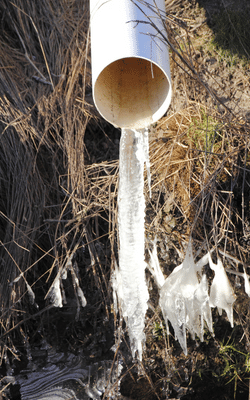We talked a little bit about preparing your home for the winter to protect you and your family from radon exposure, but there are other things that you need to winterize, especially your sump pump discharge line, before the temperature drops.
Protect Your Pump
If the sump pump in your house is doing its job, you probably don’t think about it much, if at all. However, it needs some attention to keep running its best through the winter months. Although the pump and pit are inside your warm home, the discharge line runs from the pump outside the house. This is done to empty the water well away from the structure.
If the discharge line freezes, the sump pump will continue pumping. However, the water level will not go down and the pump will eventually burn out from running continuously.
A Little About Discharge Lines

The interior waterproofing system in your home is made up of many parts, all playing an important part in keeping your basement or crawl space dry. The sump pit has a discharge line that takes the water ten to twenty feet away from the foundation. Usually, this line is buried under the soil. Sometimes it is extended out of the foundation above-grade at a downward slant.
The pipe usually freezes where the line meets the ground at the frost line. It can also freeze where the water comes out at the end. We recommend people bury the line at least 5 inches below the frost line. This useful map from Decks.com can help you determine how far down the frost line is in your part of the country. If you choose to have the pipe above-grade, the discharge line should empty at least ten feet away from the foundation wall.
Preparing the Discharge Line for Winter
There are a few things you can do to help get your discharge line ready for the winter cold. Some lines have an alternate drain that allows the water to drain closer to the house. This will allow the pump to continue working if the discharge line is frozen, but it’s not a good long-term solution. The water could eventually find it’s way back into your basement or crawl space.
Make sure that the pipe is discharging at a downward angle. Moving water takes longer to freeze than standing water and if the pipe isn’t sloped, the water could run back into the pipe, freezing the end shut.
You can insulate the discharge line and intake section of the pipe to help prevent it from freezing. Heat tape is a popular solution. This tape is an electric cable connected to a thermostat. The tape wraps around your pipes and warms them, preventing them from freezing shut.
We can’t express this enough: DO NOT USE ANTIFREEZE IN THE SUMP PUMP! The antifreeze will quickly damage your pump, leaving you with a mess, a nonworking pump, and possibly costly repairs.
Keep Your Home Dry This Winter
You’ll want to make sure your sump pump is protecting your home throughout the year. Don’t let some ice cause you to have water damage in your home. Contact Jerry’s Waterproofing today to learn more about how we can help you keep your home dry no matter the season.



